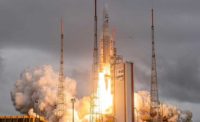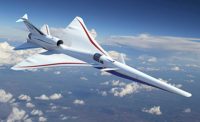Regardless of its size or past performance, every technological device can always benefit from a little help—including the very famous and large (43.3 by 13.8 feet) Hubble Space Telescope. Launched in April 1990, the telescope is expected to be functional until 2030. To complement and optimize Hubble’s performance over the next decade or so, NASA plans to launch the James Webb Space Telescope (JWST) in the spring of 2019.
Northrop Grumman is the prime contractor on the JWST project, having been awarded the $824.8 million contract in 2002. That same year, NASA partnered with the European Space Agency (ESA) and Canadian Space Agency (CSA) for their technological contributions.
The ESA was tasked with developing the telescope’s mid-infrared instrument. After a decade of work, nearly 200 engineers there created an optical system sensitive enough to see a candle on one of Jupiter’s moons. The CSA’s contributions over the years include a fine-guidance sensor and the near-infrared imager and slitless spectrograph.
Back in the United States, specialty contract manufacturers undertook various assembly projects after the telescope’s mission-critical design review was completed in April 2010. One involved engineers from the Harris Corp. (formerly ITT Exelis) using components made by Micro Instruments Corp. (MIC) to build an optical element for a center-of-curvature test system (COCOA).
This system ensures the proper height and alignment of 18 beryllium mirror segments that form the JWST’s 21.3-foot-diameter primary mirror. The system also lets engineers know if all of the segments work together to make a telescope that has the correct shape.
Completed in the fall of 2012, COCOA later underwent room-temperature testing at Micro’s facility in Rochester, NY; cryogenic testing at NASA’s Marshall Space Flight Center in Huntsville, AL; and extensive cryogenic testing in Chamber A at NASA’s Johnson Space Center in Houston. The latter testing verified that the primary mirror will operate properly at its furthest point in space: 100 million miles from Earth, in a temperature of 40 degrees Kelvin (-387.67 F or -233 C).
NASA also performed cryogenic optical testing on a non-flight replica of the telescope’s center backplane at the Johnson Center last summer. Harris built and installed custom mass spectrometers, infrared cameras and television cameras for those tests. A few years prior, the company developed and built the focal plane assembly package on the telescope’s near-infrared spectrograph detector.
Northrop Grumman’s latest assembly work involved installing five sunshield layers that protect the telescope’s optics and instruments. The layers are made of polyamide film (Kapton) and reduce the temperatures between the hot and cold sides of the observatory by approximately 570 F. Each successive layer is cooler than the one below. The sunshield, along with the rest of the spacecraft, will fold origami style into an Ariane 5 rocket when the telescope is launched between March and June 2019 from French Guiana.
Besides its contract manufacturing work on the JWST, MIC offers controls integration, mechanical engineering, and project management and validation. Other services include certified welding, rapid-build tooling, 3D printing, manufacturing documentation, precision machining and delivering complex machine parts that meet custom technical and quality standards. For more information, call 800-200-3150 or visit www.microinst.com.




